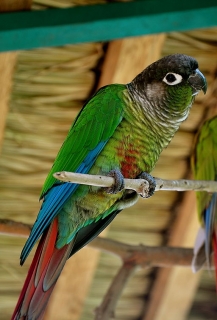Green-cheeked Conure |
|
|
Also known as: Argentine Conure, Santa Cruz Conure, Yellow-sided Conure (yellow morph)
Species Profile
Genus: Pyrrhura | Species: molinae
Size:
26cm (10.1 in)
Weight:
60-80g (2.1-2.8 oz)
Subspecies including nominate:
six: P.m. molinae, P.m. phoenicura, P.m. restricta, P.m. sordida, P.m. australis, P.m. flavoptera
Colour Adult:
P.m. molinae: Both adults brown crown to nape with green tint; bright green cheeks; pale brown chest barred with either grey/white or dull yellow near centre of breast, with feathers tipped brown; brown/red abdominal patch; scattered blue feathers on hindneck, sometimes forming faint collar; brown/red tail tipped with blue. Bill brown/grey. Eye ring bare and white. Eye brown.
P.m. phoenicura: Both adults as in molinae, but with base of tail green.
P.m. restricta: Both adults different from molinae by having brown/grey breast with white barring; green cheeks with blue tint; very visible blue collar on hindneck; strong blue wash on flanks and undertail coverts.
P.m. sordida: Green morph-both adults as in restricta but with barring on chest barely visible; yellow wash on centre of breast; blue wash on flanks and undertail coverts minimal or absent. Yellow morph-both adults have green cheeks turning yellowish towards back; yellow/white breast, barred with brown; centre of abdomen has orange/red patch; yellow flanks and thighs; yellow undertail coverts with blue suffusion; green rump and upper tail coverts with yellow markings; brown/red tail with blued tips. Bill brown/grey. Eye ring bare and white. Eye brown.
P.m. australis: Both adults paler in general than molinae; brown/red abdominal patch more extensive; dull yellow wash in centre of breast. Smaller bill.
P.m. flavoptera: Both adults as in molinae, but with orange/red bend of wing and carpal edge; alula with blue and yellow/white feathers mixed in.
Colour Juvenile:
P.m. molinae: As in adults but with no brown/red abdominal patch, may be replaced by scattered brown/red feathers. Tail shorter.
Call:
Calls made in flight are rapid and repeated notes, the second note of which is lower in tone; also sharp or melodious sounds made.
Listen NowVideo Links:
Video 1 | Video 2More Information:
Content Sources:
CITES
BirdLife International
Cornell Lab of Ornithology/Birds of the World
Parrots: A Guide to Parrots of the World, Juniper and Parr, 1998
ML Media Collection Catalogue 129329, Green-cheeked Parakeet Pyrrhura molinae, Andersen, Michael, Jujuy, Argentina, Oct. 25 2005, Cornell Lab of Ornithology. Site
Parrots of the World, Forshaw and Cooper, 1977. 2010 edition
Parrots of the World, Forshaw, 2006.
Parrots in Aviculture, Low, 1992.
Lexicon of Parrots, Thomas Arndt.
Psittacine Aviculture, Schubot, Clubb and Clubb, 1992.
Parrots: Their Care and Breeding, Low, 1986.
A Guide to Popular Conures, Dorge and Sibley, 2001.
Species Care
Captive Status:
Unknown until the 1970s; now fairly common.
Longevity:
10+ yrs
Housing:
Aviary or suspended enclosure, minimum length 2m (6.5 ft).
Diet:
Fruits such as: apple, pear, banana, cactus fruits, pomegranate, forming about 30 percent of diet; vegetables such as: carrot, celery, green beans and peas in the pod; fresh corn; green leaves such as: Swiss chard, lettuce, sowthistle, dandelion, chickweed; spray millet; small seed mix such as: canary, millet and smaller amounts of oats, buckwheat and safflower; soaked and sprouted sunflower seed; cooked beans and pulses, boiled maize and complete pellet.
Enrichment:
Are avid bathers; provide fresh water daily. Are very active so provide foraging toys, swings, ladders, bird-safe (unsprayed) wood chew toys, vegetable tanned leather toys.
Nest Box Size:
Vertical box 12" x 12" x 18"(30.5cm x 30.5cm x 46cm).
Clutch Size:
4-6
Incubation Time:
22-24 days
Fledging Age:
7 weeks
Hatch Weight:
5g (0.1 oz)
Peak Weight:
Not recorded.
Weaning Weight:
90g (3.1 oz)
Species Wild Status
World Population:
Unknown, stable.
IUCN Red List Status:
Least Concern
CITES Listing:
Appendix II
Threat Summary:
Not globally threatened. Occurrence in N Paraguay still not proven. Common in much of range with most habitat intact. Not widely traded. May be declining in E Bolivia because of rapid forest clearance.
Range:
P.m. molinae: Highlands of E Bolivia.
P.m. phoenicura: S Brazil and NE Bolivia.
P.m. restricta: Santa Cruz, E Bolivia.
P.m. sordida: S Brazil and NW Paraguay.
P.m. australis: S Bolivia and NW Argentina.
P.m. flavoptera: Cochabamba-La Paz border, N Bolivia.
Habitat:
Seen in dense, low forests and woodlands with glades, primary and secondary, including fringes of chaco, savanna, deciduous and gallery woodland in pantanal. Also in moist, mossy cloud forest on E Andes where seen up to 2900m (9512 ft).
Wild Diet:
Dry seeds, flowers, fruits, berries and nuts.
Ecology and Behaviour:
Gregarious outside breeding season. Seen in flocks of 10-20 individuals and more. Forages in tree-tops. Nest is in hollow tree.
Clutch and Egg Size:
4-6 rounded eggs, 24.0 x 19.5mm (0.9 x 0.7 in).
Breeding Season:
February. Nest is in tree hollow.
Related Links:
Wikipedia
Research: Feeding ecology of the Green-cheeked parakeet in dry forests in western Brazil
Members Only Resources
Please log-in now to find more research, resources and tools.
Not a Member?
Find more great information:
Gain exclusive access to 600+ pages of additional research, seminars and podcasts, specialists to ask your toughest questions, and dozens of other fun resources - when you become a WPT member.
Join Today >>

































